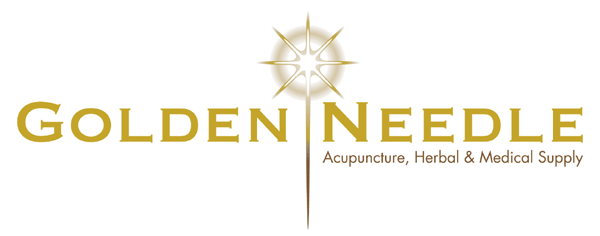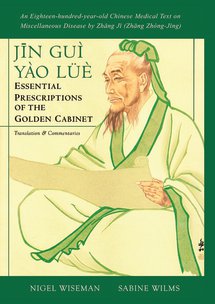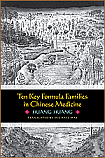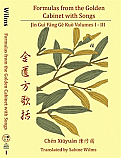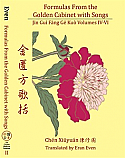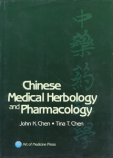| Description |
Jin Gui Yao Lue: Essential Prescriptions from the Golden Cabinet
By (author) Zhang Ji (Zhang Zhong Jing)
Translated by Nigel Wiseman, Sabine Wilms
Textual History (from the Introduction by Sabine Wilms)
As its title suggests, Zhng Zhòng-Jng’s Shng Hán Lùn discusses the diagnosis and treatment of cold damage conditions, which are conditions related to external contraction, especially of wind and cold. His Jn Guì Yào Lüè is thought to reflect that section of the original Shng Hán Zá Bìng Lùn that was called “miscellaneous diseases” ( zá bìng), basically a catch-all phrase for any conditions which could not be traced to externally contracted evils. The full title of this present text is Jn Guì Yào Lüè Fng Lùn, “Essential Prescriptions and Discussions from the Golden Cabinet.” This title tells us several things about the book. First, it is an indication of the value that the author (or more accurately, the person who named the text as such) placed on the book’s content. “Golden Cabinet” refers to a cabinet-like storage box made of gold, hence a place where a person of great wealth would store his or her most valuable items. Second, the text is characterized as containing both “prescriptions” and “discussions,” or in other words, clinical as well as theoretical information. This combination positions it at an interesting fulcrum in the textual history of Chinese medicine, namely the intersection between theoretical classics like the Huáng Dì Nèi Jng (“Yellow Emperor’s Inner Canon”) and Nàn Jng (“Classic of Difficult Issues”), which were mostly concerned with the flow of qì and blood through the vessels and the correlation of the human body to the macrocosm, and formulary collections like the Qin Jn Fng (“Thousand Gold Pieces Prescriptions”) by Sn S-Mio, which primarily matched lists of symptoms to specific formulas without providing any diagnostic or etiological explanation for the rationale behind a treatment. By contrast, the Jn Guì Yào Lüè includes detailed diagnostic guidelines and etiological reasoning in addition to instructions for treatment primarily with medicinal formulas (and some references to acupuncture, moxibustion, and other therapeutic modalities). Zhng Zhòng-Jng thus created a medical classic with outstanding significance for both theory and practice, centuries before other medical authors attempted to follow in his footsteps during the Sòng period.
Due to the turbulence of its historical times, it is impossible to reconstruct the exact format, content, and organization of Zhng Zhòng-Jng’s work today. Nevertheless, its significance for the history of medicine and its applicability in modern clinical practice has inspired much research, especially in China, to approximate its original form as much as possible on the basis of later reprints, fragments that have been recovered in China and Japan in archaeological sites, and quotations in received texts.
By order of the Sòng Imperial court in the 11th century, both the Shng Hán Lùn and the Jn Guì Yào Lüè were included among a small selection of early Chinese medical classics to be collated, annotated, and reissued in woodblock print. This monumental effort was completed by a large editorial team from the Office for the Correction of Medical Texts, which had been established in 1057 CE. While these scholars had access to the ten scrolls of the Shng Hán Lùn which had been edited by Wáng Sh-Hé, the part on “miscellaneous diseases” had not survived. Instead, they painstakingly had to recreate the Jn Guì Yào Lüè on the basis of quotations found in other medical classics like the Mài Jng (“Pulse Canon”), Zh Bìng Yuán Hòu Lùn (“Origin and Indicators of Disease”), and Qin Jn Fng (“Thousand Gold Pieces Prescriptions”), as well as a summary of Zhng Zhòng-Jng’s work in three scrolls entitled Jn Guì Yù Hán Yào Luè Fng (“Essential Prescriptions from the Golden Cabinet and Jade Sheath”). These Sòng editors matched the prescriptions with the descriptions of symptoms, arranged the text by disease categories into 25 chapters in three parts, and lastly added select outstanding prescriptions by other physicians of the times, all with the goal of making this text as clinically useful as possible. This Sòng revision has been the standard version of the text ever since, and also the version on which subsequent editions such as this one are based. It is thus important for the discerning reader to keep in mind that we are looking at a Hàn dynasty text that was lost for several centuries and reconstructed, rearranged, and supplemented by Sòng dynasty scholars approximately eight hundred years later.
Main Description
The Jn Guì Yào Le (“Essential Prescriptions of the Golden Cabinet”), like its sister volume the Shng Hán Lùn (“On Cold Damage”), is a gem reconstituted from fragments of a lost text called the Shng Hán Zá Bìng Lùn (“On Cold Damage and Miscellaneous Diseases”) by indisputably the most brilliant medical mind that China ever produced, the Hàn Dynasty physician Zhng J (Zhng Zhòng Jng). Exerting an influence on the development of Chinese medicine unmatched by any other medical scholar, Zhng integrated the then relatively new theories of systematic correspondence of the Nèijng and Nànjng with an already vast practical knowledge knowledge in the use of medicinals. Such was his brilliance that it was not fully recognized by Chinese physicians until centuries later in the Sòng Dynasty, when Zhng’s combination of theory and practice became the mainstream in Chinese medicine that survived centuries of scrutiny from successive generations of medical scholars and buttressed traditional medicine against the challenge of Western in the twentieth century. Combining theoretic etiologies with detailed diagnosis and skillfully devised treatments, Zhng’s work has left an indelible print on traditional medicine in China for nearly 2,000 years. A third of the most commonly used formulas in Chinese medical practice today were devised by Zhng J.
The Jn Guì Yào Le covers diseases other than the external contractions dealt with in the Shng Hán Lùn, and includes lung diseases, water swelling, dissipation-thirst, impediment (bì), summerheat stroke, mounting diseases, and gynecological diseases, to name just a few. It is presented in 25 chapters, most of which deal with two or three closely related diseases; however the final three chapters cover miscellaneous formulas and foodstuffs. Each chapter includes an introduction to the material, followed by the original lines of the text, which are rendered in simplified Chinese characters, Pnyn, and English translation. This is followed by notes to elucidate obscure phrases in the original text, a synopsis of the content of the line, and detailed explanatory commentaries.
Praise for *Jin Gui Yao Lue: Essential Prescriptions from the Golden Cabinet
“Wiseman and Wilms have exquisitely translated the Jn Guì Yào Lüè. The English rendering is impeccable, precise, and consistent. The detailed commentaries are systematic and comprehensive. Throughout my forty-six years as a clinician I have studied Zhng J’s writings and prescribed formulas from the Shng Hán Lùn and Jn Guì Yào Lüè. I hope that this remarkable work in its English translation will help you to draw upon the genius of Zhng J and to understand and utilize the depth of his knowledge of Chinese medicine.”
Miki Shima, OMD, L.Ac., President, JapaneseAmerican Acupuncture Association; Former Member, California State Acupuncture Examining Committee; Former President, California Acupuncture Association; Author, Expositions on the Eight Extraordinary Vessels; Channel Divergences – Deeper Pathways of the Web; The Medical I Ching: Oracle of the Healer Within; Recipient, Lifetime Achievement Award, American Association of Acupuncture and Oriental Medicine (2004)
Flap Copy
Nigel Wiseman, a native of Great Britain, received his bachelor’s degree in Spanish and German interpreting and translation in 1976 from Herriot Watt Univeristy in Edinburgh, and his doctorate in 2000 from the University of Exeter, He has lived in Taiwan for the last thirty years, where he is a lecturer at Chang Gung University and an editorial board member for the Journal of Chinese Medicine (ROC), the China Medical College Journal (ROC), and Clinical Acupuncture and Moxibustion Journal (UK). He has authored a number of seminal Chinese medical works in English, including Fundamentals of Chinese Medicine, A Practical Dictionary of Chinese Medicine, Chinese Medical Chinese: Grammar and Vocabulary, and Concise Chinese Materia Medica, and has translated into English both the Shng Hán Lùn and the Jn Guì Yào Lüè.
Sabine Wilms received her B.A. from Julius-Maximilians Universität in Würzburg, Germany, in 1990. She studied Chinese language at Fu Jen University, Taipei, Taiwan, and at Tunghai
University, Taichung, Taiwan. Subsequently she completed her M.A., A.B.D., and Ph.D in Chinese Studies at University of Arizona, graduating in 2002. Since 2002 she has worked as a translator, interpreter, researcher, and consultant at the University of Arizona Medical Center in the Department of Pediatrics, and as senior editor for Paradigm Publications (Taos, NM). She is the co-author, along with Andreas Noll, of Chinese Medicine in Fertility Disorders (2009). Currently she maintains a professional presence as translator, lecturer, and consultant in Chinese language and history.
|
